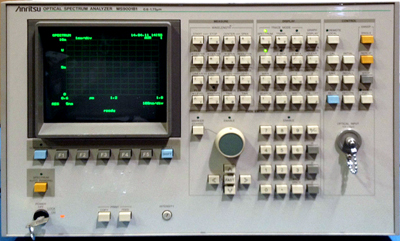
|
|
The Anritsu MS9001B Optical Spectrum Analyzer covers wavelengths up to 1.75 µm and can be used to measure 1.55 µm band light-emitting elements developed for long distance optical communications as well as the loss characteristics of optical parts and materials using white-light sources (MG922A). The 45 dB dynamic range of the MS9001B has been achieved by using a spectroscope that has less stray light. This permits accurate measurement of DFB laser side-modes. Specifications. Wavelength range: 0.6 to 1.75 µm. Level measuring range: -70 to +10 dBm (0.7 to 1.6 µm), - 65 to + 10 dBm (0.6 to 1.7 µm), -55 to +10 dBm (1 .6 to 1.75 µm). Measuring level accuracy: ±2 dB (at 0 .85/1.3/1.55 µm). Linearity: ± 0.5 dB/10 dB, ± 1 dB/20 dB, ± 3 dB/60 dB. Polarization: ±0.5 dB (at 1.3/1.55 µm). Level scale: 0.2 to 10 dB/div and LINEAR. Dynamic range (background light level): >=35 dB (level difference between peak level and ± 1 nm from peak level), >=45 dB (level difference between peak level and ± 10 nm from peak level). Wavelength read-out resolution: 2 pm. Wavelength accuracy: ±1 nm, ±0.5 nm (25°C). Resolution bandwidth: 0.1 to 5 nm. Wavelength sweep width: 0 to 100 nm/div. Processing functions: Automatic setting for optimum measurement, subtraction, averaging, peak-search, peak-to-center, spectrum half-width, wavelength calibration, title display, time display, memory backup, direct plotting.
|